The Leibniz-IZW is an internationally renowned German research institute. It is part of the Forschungsverbund Berlin e.V. and a member of the Leibniz Association. Our goal is to understand the adaptability of wildlife in the context of global change and to contribute to the enhancement of the survival of viable wildlife populations. For this purpose, we investigate the diversity of life histories, the mechanisms of evolutionary adaptations and their limits, including diseases, as well as the interrelations of wildlife with their environment and people. We use expertise from biology and veterinary medicine in an interdisciplinary approach to conduct fundamental and applied research – from the molecular to the landscape level – in close dialogue with the public and stakeholders. Additionally, we are committed to unique and high-quality services for the scientific community.
+++ Current information on African swine fever: The Leibniz-IZW conducts research on the population dynamics, on models of disease outbreaks in wild boars and on the ecology and human-wildlife interaction in urban areas. African swine fever is a reportable disease in domestic swine and therefor is the purview of the respective federal state laboratories and the Friedrich-Loeffler-Institut (Federal Research Institute for Animal Health) FLI. +++
News
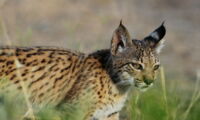
Preservation of testicular cells to save endangered feline species
A research team at the German Leibniz Institute for Zoo and Wildlife Research (Leibniz-IZW) developed a method to isolate and cryopreserve testicular cells. This will allow the safekeeping and biobanking of gametes and other cells of the male reproductive tract of threatened or endangered feline species. The findings have been published in the scientific journal "Cryobiology".
Read more … Preservation of testicular cells to save endangered feline species
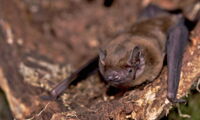
Bats depend on conspecifics when hunting above farmland
Common noctules – one of the largest bat species native to Germany – are searching for their fellows during their hunt for insects above farmland. Scientists from the Leibniz Institute for Zoo and Wildlife Research (Leibniz-IZW) show in a paper published in the journal “Oikos” that bats forage on their own in insect-rich forests, but hunt collectively in groups over insect-poor farmland. They seem to zoom in on places where conspecifics emit echolocations during the capture of insects, an inadvertent clue that reveals high-yielding areas to others. However, “listening” to their hunting companions to find food only works when sufficient numbers of bats forage in the same area. If numbers continue to decline, density could fall below a critical level and joint hunting could become difficult or impossible. This could pose an additional threat to the survival of species such as the Common noctule.
Read more … Bats depend on conspecifics when hunting above farmland
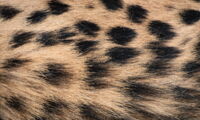
Hair in “stress”: analyse with care
Similar to humans, wild animals’ reaction to disturbance is accompanied by releasing hormones, such as cortisol. To understand the impact of various “stress” factors – for example competition for food, encounters with predators, or changing environmental conditions – on wildlife, scientists first need to determine the baseline levels of relevant hormones for each species. Researchers from the Leibniz Institute for Zoo and Wildlife Research (Leibniz-IZW) now uncovered possible pitfalls of the commonly used hormone analysis method that overestimate concentrations of cortisol and thus lead to overstated conclusions. They investigated whether glucocortiocoid hormones deposited in animal hair can be reliable biomarkers to indicate the impact of disturbances. The source of errors in the commonly used antibody-based enzyme immunoassays (EIA) method is described in a recently published article in the scientific journal “Conservation Physiology”.
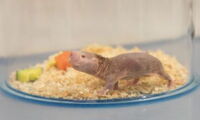
Newly confirmed biochemical mechanism in mouse, bat and naked mole rat cells is a key component of the anti-ageing program
Ageing is an inevitable part of life, yet some species are ageing very differently than others, even than very similar ones. Naked mole rats for example, an east African rodent of a size comparable to moles or mice, show a strongly delayed process of ageing and live up to 30 years. Scientists from Russia, Germany and Switzerland now confirmed a mechanism in mouse, bat and naked mole rat cells – a “mild depolarization” of the inner mitochondrial membrane – that is linked to ageing: Mild depolarization regulates the creation of mitochondrial reactive oxygen species (mROS) in cells and is therefore a mechanism of the anti-ageing program. In mice, this mechanism falls apart at the age of 1 year, while in naked mole rats this does not occur until ages of up to 20 years. This newly confirmed mechanism is described in detail in a paper published in the “Proceedings of the National Academy of Sciences of the USA”.

City fox and country fox – genetics reveal behavioural and physical barriers between urban and rural red foxes in and around Berlin
For wildlife, cities can present new opportunities as well as threats. Researchers from the Leibniz Institute for Zoo and Wildlife Research (Leibniz-IZW) and the Luxembourg National Museum of Natural History (NMNH) analysed genetic material of red foxes (Vulpes vulpes) inhabiting Berlin and its surroundings. They identified two genetically distinct, adjacent “urban” and “rural” fox populations and revealed that physical barriers such as rivers or man-made structures reduce the exchange between these populations but also differences in human activity in these landscapes play a major role. The researchers suggest that avoidance of sites of human activity may drive foxes into costly trade-offs as they prefer to disperse along potentially dangerous transportation infrastructures. The study was recently published in the scientific journal “Molecular Ecology”.
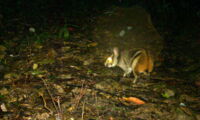
Landscape-level surveys are necessary to address large-scale wildlife losses from poaching
Widespread poaching in tropical biodiversity hotspots is causing unprecedented declines in wildlife populations, known as defaunation. A new study published in the journal “Diversity & Distributions”, provides evidence that large-scale systematic surveys and novel methods of data collection and analysis, are necessary to assess the extent and distribution of poaching and its impact on biodiversity in forest exposed to severe defaunation. Mapping biodiversity in this way will provide information critical to protecting rare species that may still exist in these landscapes. The research was conducted in the Annamite mountains on the border of Laos and Vietnam, an area with an exceptionally high occurrence of endemic species that is threatened by illegal poaching through the setting of wire snares. The research team, led by the Leibniz Institute for Zoo and Wildlife Research (Leibniz-IZW), comprised scientists, conservationists and government counterparts, including representatives from WWF-Vietnam and WWF-Laos.
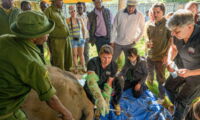
Newly created embryo nourishes hope for the survival of the northern white rhino
Nairobi, Kenya - In August 2019 a team of scientists and conservationists broke new ground in saving the northern white rhinoceros from extinction. They harvested eggs from the two remaining females, artificially inseminated those using frozen sperm from deceased males and created two viable northern white rhino embryos. With great support from the Kenyan Government and in the presence of Hon Najib Balala, – Kenya’s Cabinet Secretary, Ministry of Tourism and Wildlife – the team repeated the procedure on December 17, 2019, and was able to create a new embryo over Christmas. This significantly increases the chances of successfully producing offspring. The procedure has proven to be safe and reproducible, and can be performed on a regular basis before the animals become too old. Preparations for the next steps of the northern white rhino rescue mission are underway.
Read more … Newly created embryo nourishes hope for the survival of the northern white rhino
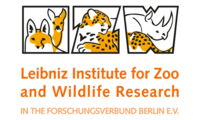
Prof. Hildebrandt named “Human Panda Personality of the Year” for achievements in assisted reproduction
Since 2012 the Giant Panda Global Awards honour conservation work for the Giant Panda all over the world. Awardees include individual pandas, offspring as well as zoological gardens, veterinary teams, keepers and other personalities with significant achievements in giving these charismatic animals a future on our planet. In the 2019 edition of the awards Prof Dr Thomas B. Hildebrandt was named “Human Panda Personality of the Year” (Gold Award) for remarkable achievements in applying assisted reproduction technologies and imaging techniques in giant panda.




